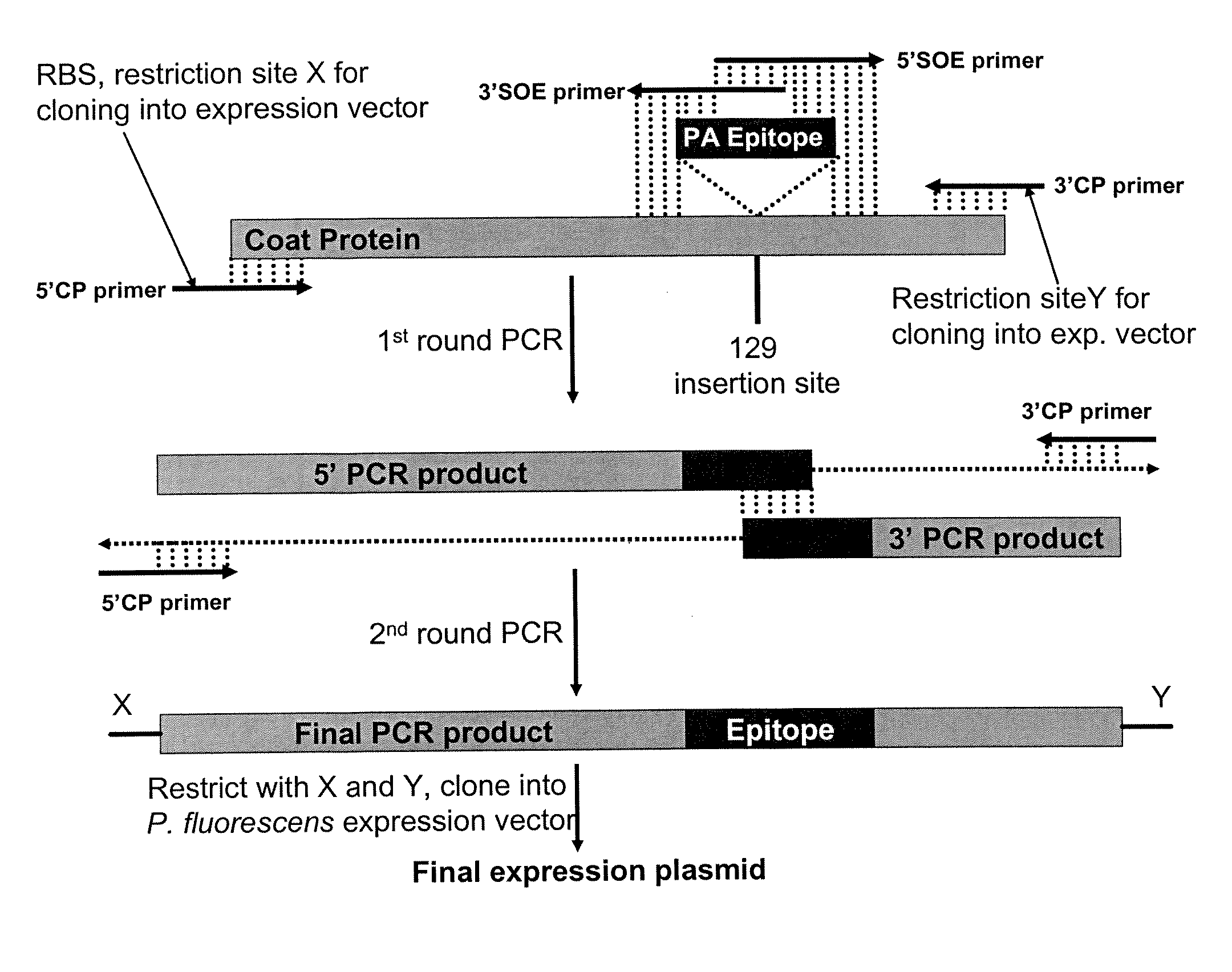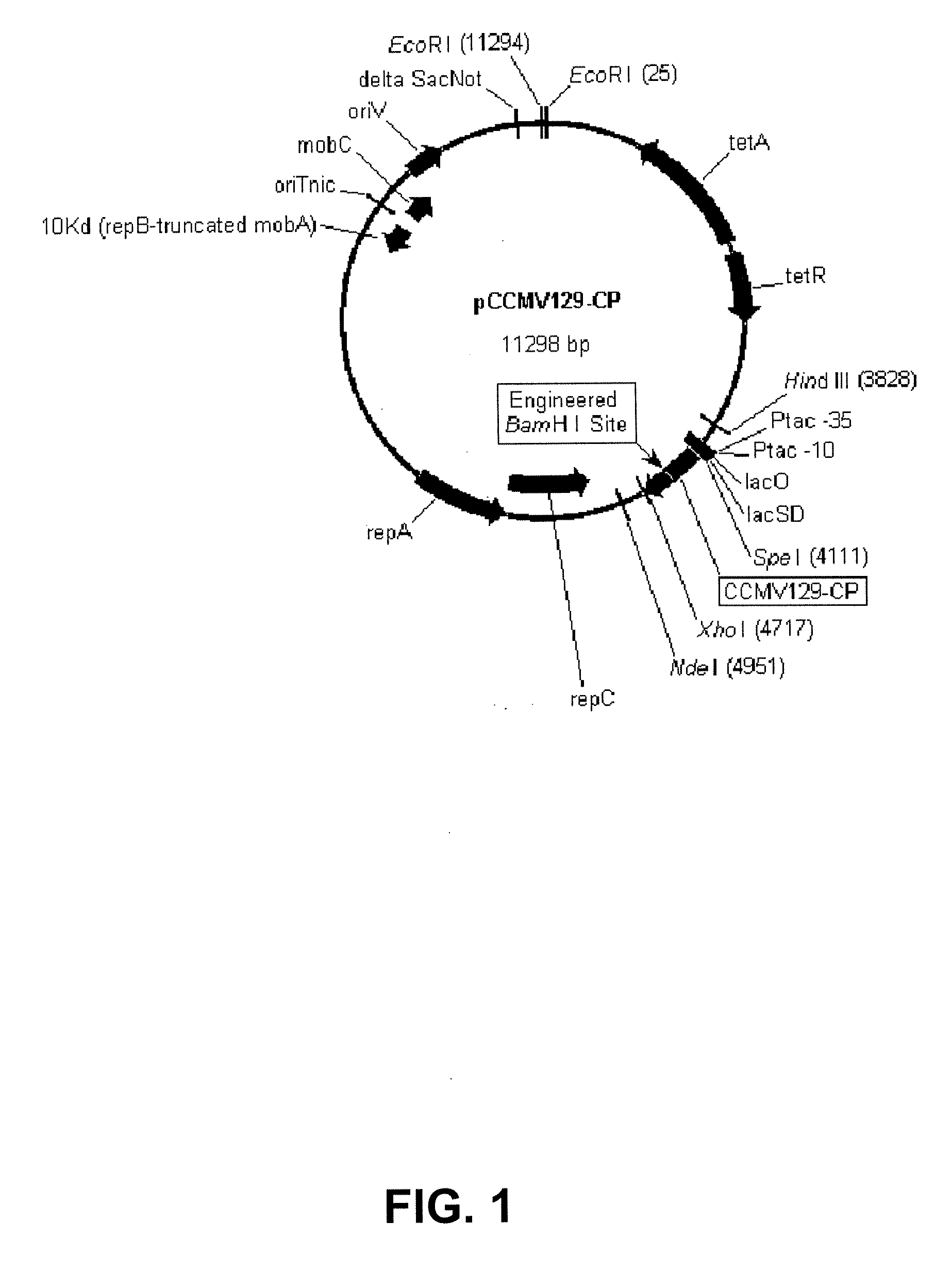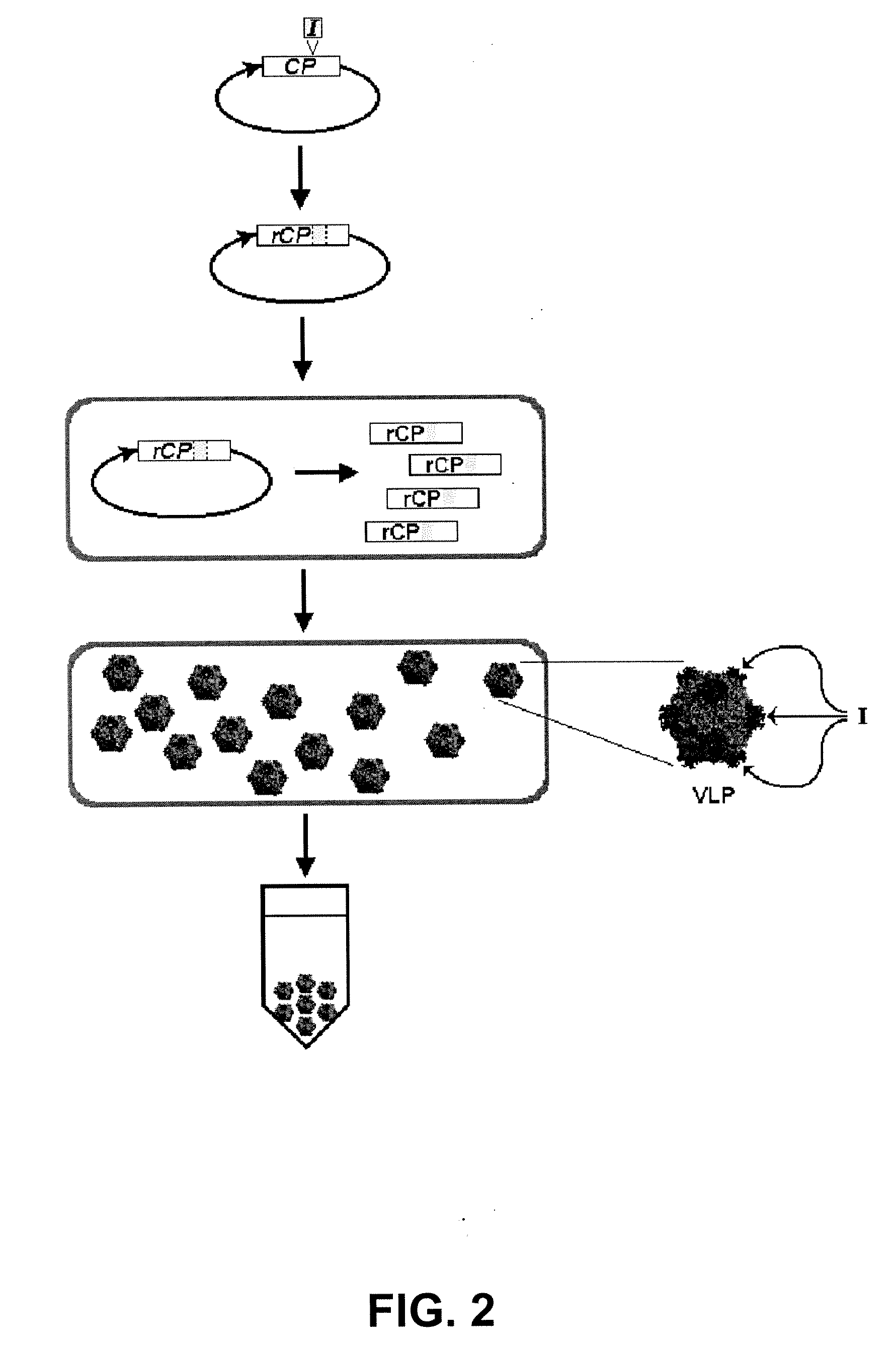Production and in vivo assembly of soluble recombinant icosahedral virus-like particles
a technology of icosahedral virus and soluble recombinant, which is applied in the direction of peptides, antibody medical ingredients, peptide sources, etc., can solve the problems of inability of bacteria to produce certain types of peptides, requiring the use of alternative and more expensive expression systems, and cell death upon the expression of peptides, etc., to achieve the effect of increasing the yield of soluble vlps and optimizing the hydrophili
- Summary
- Abstract
- Description
- Claims
- Application Information
AI Technical Summary
Benefits of technology
Problems solved by technology
Method used
Image
Examples
example 1
Cloning of Expression Plasmid for Expression of Codon and Hydrophilicity Optimized CCMV Capsid Protein in Pseudomonas fluorescens
[0210]Codon and hydrophobicity optimized CCMV CP nucleotide sequence was designed (SEQ ID NO:3). CCMV-CP insert (SEQ ID NO:3) containing the SpeI restriction site, ribosome binding site, CP ORF, and XhoI restriction site is excised out of a shuttle plasmid (DNA 2.0, Menlo Park, Calif.) with SpeI and XhoI. The insert is gel purified on a 1% agarose gel and ligated into the vector pDowl 169 (a medium copy plasmid with RSF1010 origin, pyrF, tac promoter, and the rrnBT1T2 terminator from pKK223-3 (PL-Pharmacia)), which is digested with SpeI, XhoI and treated with Alkaline Phosphatase (New England Biolabs) to create an expression plasmid for CCMV CP expression in Pseudomonas fluorescens (SEQ ID NO:23). The ligation product is transformed by electroporation into P. fluorescens strain DC454 (ΔpyrF RXF01414 (lsc)::lacIq1) after purification with Micro Bio...
example 2
Introduction of Restriction Sites into Loops of Codon and Hydrophilicity Optimized CCMV Capsid Protein
[0213]Site-directed mutagenesis reactions are carried out using Quikchange II-XL (Stratagene, TX) according to manufacturer's protocol. The P. fluorescens expression plasmid harboring codon-optimized CCMV-CP (SEQ ID NO:23) serves as a template. Resulting plasmids with introduced restriction sites are transformed into P. fluorescens strain DC454 (ΔpyrF RXF01414 (lsc)::lacIq1) by electroporation after purification with Micro Bio-spin 6. Protein expression is performed as described in Example 1.
Primers for Introduction of Blunt-End Cutting Restriction Site AfeI I onto 63 Loop:
CCMV-AfeI-63-F (SEQ ID NO:24):5′-TGCGCGGCTGCCGAGAGCGCTGCCAAGGTCACCAGT-3′CCMV-AfeI-63-R (SEQ ID NO:25):5′-ACTGGTGACCTTGGCAGCGCTCTCGGCAGCCGCGCA-3′
Primers for Introduction of 3′-Overhang-Cutting Restriction Site PvuI into 102 Loop:
CCMV-PvuI-102-F (SEQ ID NO:26):5′-CTGCCGAGTGTGTCCCGATCGGGCACCGTCAAGTCC-3′CCMV-PvuI-102-...
example 3
Restriction Digestion-Based Cloning and Expression of Flu Vaccine M2e Peptide Fused to the 129 Surface Loop of Codon and Hydrophilicity Optimized CCMV Capsid Protein
Peptide Synthesis:
[0214]The insert is synthesized by over-lapping DNA oligonucleotides described below with the thermocycling program detailed below:
PCR PROTOCOLReaction Mix (100 μL total volume)Thermocycling Steps10μL10X PT HIFI buffer*Step 1 1 Cycle 2 minute94° C.4μL50 mM MgSO4*Step 235 Cycles30 second94° C.2μL10 mM dNTPs*30 second55° C.0.25ngEach Primer 1 minute68° C.1-5ngTemplate DNAStep 3 1 Cycle10 minute70° C.1μLPT HIFI Taq DNA Polymerase*Step 4 1 CycleMaintain 4° C.RemainderDistilled De-ionized H2O (ddH2O)*(from Invitrogen Corp, Carlsbad, CA)
[0215]The PCR product is purified with Qiaquick® PCR purification kit (Qiagen), digested with XbaI (NEB) and purified again with Qiaquick® kit before ligating into XbaI restricted CCMV CP P. fluorescens expression vector containing XbaI restriction site in the 129 loop (from E...
PUM
| Property | Measurement | Unit |
|---|---|---|
| diameter | aaaaa | aaaaa |
| temperature | aaaaa | aaaaa |
| cell density | aaaaa | aaaaa |
Abstract
Description
Claims
Application Information
 Login to View More
Login to View More - R&D
- Intellectual Property
- Life Sciences
- Materials
- Tech Scout
- Unparalleled Data Quality
- Higher Quality Content
- 60% Fewer Hallucinations
Browse by: Latest US Patents, China's latest patents, Technical Efficacy Thesaurus, Application Domain, Technology Topic, Popular Technical Reports.
© 2025 PatSnap. All rights reserved.Legal|Privacy policy|Modern Slavery Act Transparency Statement|Sitemap|About US| Contact US: help@patsnap.com



